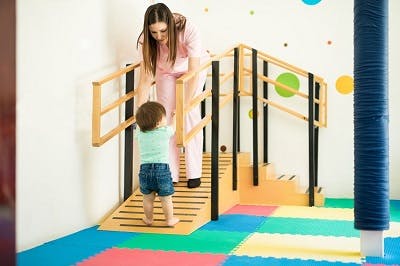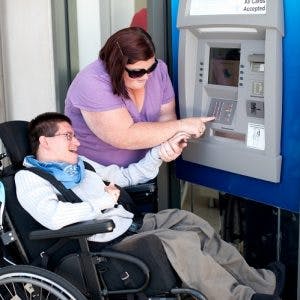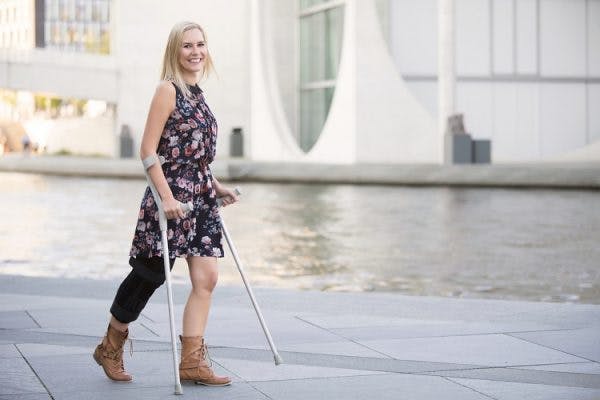Spastic diplegia is one of the most common types of cerebral palsy. While it may mildly affect the arms, spastic diplegia primarily affects the muscles in the legs. As a result, individuals with this type of CP may experience challenges with balance, walking, and growth.
To help you understand what spastic diplegia is, this article will discuss:
- What causes spastic diplegia?
- What are the signs and symptoms of spastic diplegia?
- Is spastic diplegia treatable?
Causes of Spastic Diplegia
Cerebral palsy is caused by damage to the developing brain before, during, or shortly after birth. Common causes of early brain damage include premature birth, infection, and lack of oxygen to the brain.
Depending on the size and location of damage to the brain, different areas of the body can be affected at various severities. For example, damage to the cerebellum causes ataxic cerebral palsy while damage to the motor cortex causes spastic cerebral palsy.
Spastic diplegia is a type of spastic cerebral palsy that primarily affects motor control in the legs. Generally, this type of spastic CP is associated with milder damage to the brain, which is why motor impairments primarily affect the legs as opposed to the entire body.
However, it’s important to understand that lower body motor impairments can still have significant consequences. Fortunately, when properly managed through rehabilitative therapies and other treatment interventions, individuals with spastic diplegia can improve their quality of life. In the following section, we’ll discuss the potential effects of spastic diplegia.
Signs and Symptoms of Spastic Diplegia
Most individuals with spastic diplegia have normal cognitive abilities and can walk independently. However, some individuals may experience more severe motor impairments and may be dependent on an assistive mobility device such as a crutch, wheelchair, or walker.
It’s ideal to identify the signs of cerebral palsy as early as possible so that your child can get the treatment they need to minimize the impact of their motor impairments and avoid forming poor movement habits.
Common signs and symptoms of spastic diplegia include:
Spasticity
All individuals with spastic diplegia experience some form of involuntary muscle contractions called spasticity. Spasticity occurs because damage to the motor cortex disrupts the transmission of signals from the brain to the muscles. As a result, the muscles associated with the area of damage remain involuntarily contracted.
Spasticity is the underlying cause of many secondary complications of cerebral palsy including abnormal walking patterns, pain, and distorted growth.
While the brain damage that causes cerebral palsy does not worsen over time, spasticity can. If left unmanaged, spasticity can severely restrict mobility and result in the inability to walk.
Abnormal Gait

Most people with spastic diplegia have an abnormal gait (walking pattern) because the muscles in their legs cannot fully relax due to spasticity. The continuous muscle contractions result in stiff movements that make it difficult for individuals to maintain balance when they walk.
Common abnormal gait patterns in individuals with spastic diplegia include:
- Scissor gait (walking with the knees turned inwards)
- Tiptoeing (walking on the toes)
- Crouch gait (walking with continuously bent knees, hips, and ankles)
Muscle Weakness
Severe spasticity in the legs can discourage individuals from participating in physical activity. Our bodies build strength through everyday movements that place pressure on the joints, bones, and muscles. Without regular physical activity, the muscles and bones start to weaken, which increases one’s risk of injury.
Delayed Developmental Milestones
A combination of spasticity and muscle weakness can contribute to delayed developmental milestones such as crawling, standing, and walking. This doesn’t mean that children with spastic diplegia will never be able to walk; rather, it may just take them longer to learn how to. In fact, nearly 50-60% of children with cerebral palsy walk independently.
Those with more severe motor impairments who are unable to walk without assistance are taught how to use mobility aids such as walkers and wheelchairs to maximize their independence.
Limited Growth and Development
Spasticity at an early age can significantly affect a child’s growth and development. Individuals with spastic diplegia may develop deformities or distortions due to disproportional amounts of pressure on various muscles, joints and bones in the legs. For example, one leg may be longer than the other due to increased muscle strain in the shorter leg.
Now that you understand the potential signs and symptoms of spastic diplegia, let’s discuss treatment and the importance of early intervention.
Spastic Diplegia Treatment
While cerebral palsy is a lifelong condition, individuals can learn to significantly improve their quality of life with the right treatment. Spastic diplegia can range from mild to severe and affect various muscles in the legs differently, so a personalized approach to treatment is essential.
Treatment for spastic diplegia primarily focuses on promoting the brain’s ability to make adaptive changes and rewire its neural circuitry called neuroplasticity. This mechanism is what allows for functions affected by brain damage to be rewired to healthy, unaffected areas of the brain.
The most effective way to promote neuroplasticity is to focus on task-specific repetition. The brain functions on demand, so the more you practice any skill, the stronger the neural pathways for it will become.
At young ages, the brain has a higher level of neuroplasticity, making early intervention ideal. However, the brain never loses its ability to adapt, so there is potential for improvement at any age.
Management interventions for spastic diplegia typically include:
1. Physical Therapy

Physical therapy is essential for minimizing the impact of spasticity in the legs. At physical therapy, individuals with spastic diplegia may work on stretching spastic muscles, strengthening underused muscles, and walking with improved form.
Gait training is a type of physical therapy that specifically concentrates on improving one’s ability to walk. It can involve practicing exercises in the pool or walking on a weight-bearing treadmill. These activities relieve pressure on the joints, which allows individuals to focus on improving their form. They also minimize the chances of falling and the likelihood of injury resulting from a fall, which often makes individuals feel more comfortable with practicing more challenging skills.
Many physical therapists will incorporate games and activities, such as obstacle courses and balancing challenges, into their treatments with pediatric patients. This is a great way to motivate children with spastic diplegia to be fully engaged in therapy and can allow parents to more easily encourage practicing the skills learned in physical therapy at home.
Physical therapy is an effective form of treatment for spastic diplegia because it focuses on repetitions, which consistently stimulates the brain. The more you practice, the more you’re activating neuroplasticity and strengthening those brain-to-muscle connections.
2. Occupational Therapy
Occupational therapy focuses on promoting independence through activities of daily living.
Individuals with spastic diplegia are generally capable of being very independent because their motor impairments mainly affect their lower limbs. Therefore, they can learn how to use their arms to assist with everyday activities such as performing transfers, dressing, and toileting.
If motor impairments are more severe, an occupational or physical therapist may teach patients how to use mobility aids like walkers, crutches, and/or wheelchairs. Occupational therapists may also educate patients on how to use adaptive equipment, such as a sock aid or leg lifter, to increase their functional independence.
3. Botox/ Muscle Relaxants
Botox and muscle relaxants block signals that cause spastic muscles to tighten. This helps delay the progression of contractures and provides temporary spasticity relief.
Because spastic diplegia primarily affects the muscles in the legs, oral medications that affect the entire body are generally not ideal. Instead, direct injections to the affected muscles are more effective.
Because the effects of Botox and muscle relaxants are not permanent, individuals should take advantage of the period of reduced spasticity and intensely pursue physical therapy to promote more long-term relief.
4. Orthotics
Orthotics such as braces, splints, and casts are wearable devices that help keep the body correctly aligned.
Spasticity pulls the body out of alignment and causes unnecessary strain on the joints. This pressure may interfere with a child’s growth and cause serious complications such as hip dislocations. Orthotic devices help mildly stretch spastic muscles and provide structural support to prevent the muscles from further tightening. They can also help with maintaining positioning and stability to increase independence with walking and completing transfers.
5. Surgery
Surgeries for spastic diplegia typically consist of manually lengthening and realigning the muscles or selective dorsal rhizotomy. A selective dorsal rhizotomy involves making incisions at specific nerve roots to permanently sever innervation and reduce the excitability of the spastic muscle.
Surgeries are typically only recommended for very severe cases of spasticity.
Living with Spastic Diplegia: Key Points
Spastic diplegia is a type of cerebral palsy that primarily affects the legs. If not properly managed, it can significantly affect one’s growth and ability to walk.
Fortunately, the impact of motor impairments caused by cerebral palsy can be managed by promoting neuroplasticity.
Intensively working toward recovery is the best way to make progress and become as independent as possible. Thousands of repetitions are required to promote neurological changes, so it’s essential to stay motivated, commit to your exercises, and trust in the process. The more you practice, the more you’re stimulating the brain and promoting its ability to adapt.
We hope this article helped you understand what spastic diplegia is and how to treat it.










